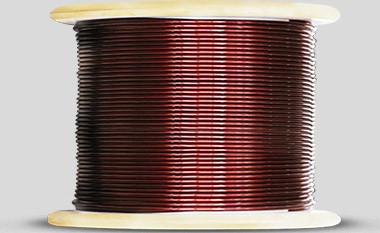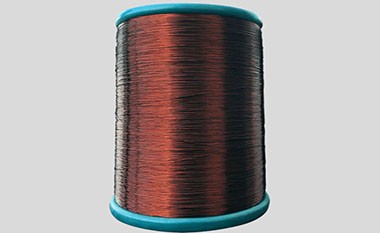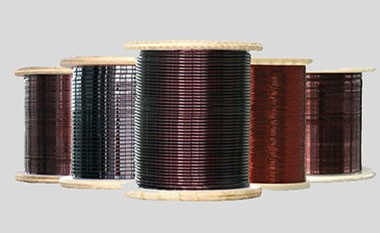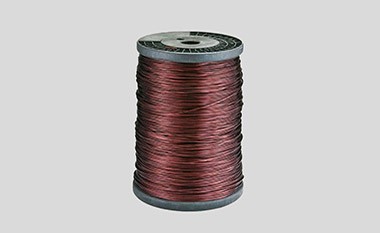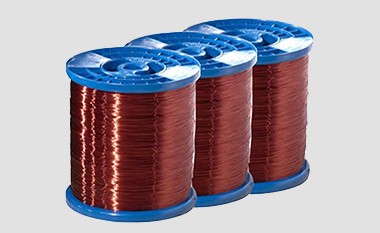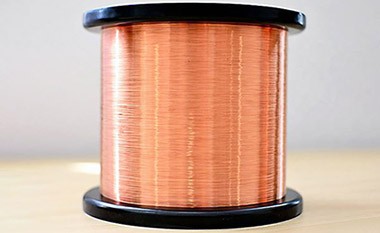Enameled Rectangular (Flat) Aluminum Wire
Enameled rectangular (flat) aluminum wire is a widely used conductive material in fields such as motors, transformers, and electronic devices. It is produced by drawing aluminum through molds to create a flat shape, followed by multiple painting processes.
Enameled rectangular aluminum wire typically uses high-purity aluminum alloys to ensure its electrical conductivity and mechanical properties. Common aluminum alloys include 1060 and 1350.
The surface of enameled rectangular aluminum wire forms a strong oxide layer, which enhances its insulation performance and reduces wear during use, thereby extending its lifespan.
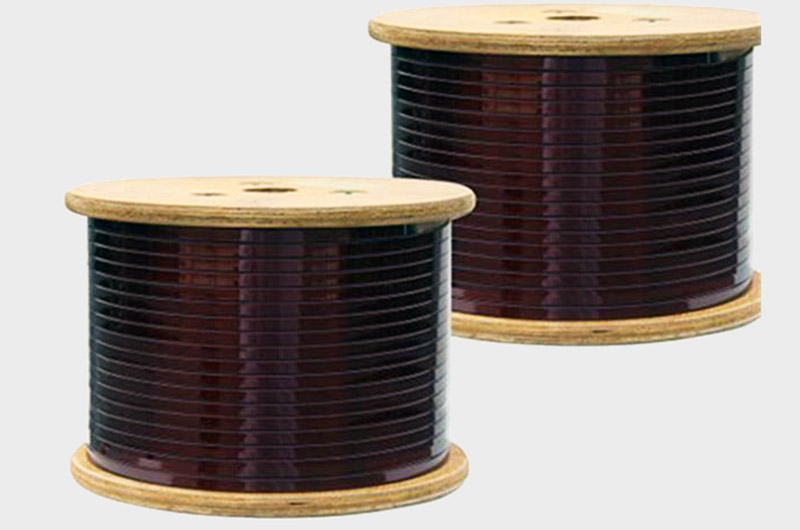
Features of Enameled Rectangular (Flat) Aluminum Wire
- 1. Lightweight: Enameled rectangular aluminum wire is approximately 1/3 the weight of copper wire, reducing the overall weight of equipment and facilitating transportation and installation.
- 2. High heat resistance: Due to the insulating effect of the aluminum film layer, its heat resistance temperature can be 20 degrees higher than that of copper wire, making it suitable for use in high-temperature environments.
- 3. Excellent electrical performance: Aluminum has good electrical conductivity, which is sufficient to meet the needs of most electrical applications.
- 4. Cost-effectiveness: Compared to copper wire, the production cost of enameled rectangular aluminum wire is significantly lower, making it more competitive in many industries.
- 5. Insulation performance: The oxide layer formed on the surface of enameled rectangular aluminum wire has excellent insulation properties, effectively preventing short circuits and leakage, thereby extending the product's lifespan.
Enameled Rectangular (Flat) Aluminum Wire Parameters
| Parameter | Range |
| Flat wire thickness | 0.80 - 5.60 mm |
| Flat wire width | 2.00 - 16.00 mm |
| Width/Thickness ratio | 1.4 < w/t < 8.0 |
| Temperature class | 130°C, 155°C, 180°C, 200°C, 220°C, 240°C |
Enamelled Aluminium Flat Wire Insulation Layer
Enamelled aluminium flat wire consists of an aluminium conductor coated with an insulation material to prevent short circuits and ensure electrical performance. Different types of insulation materials have distinct characteristics, making them suitable for various working environments and applications.
Polyurethane Enamelled Aluminium Flat Wire
- Characteristics: The polyurethane insulation layer offers excellent heat resistance and chemical resistance, maintaining stability in high-temperature and humid environments.
- Applications: Suitable for motors and transformers that require high-temperature resistance, especially in harsh environments such as aviation, aerospace, and automotive industries.
Polyester Enamelled Aluminium Flat Wire
- Characteristics: The polyester insulation layer provides good electrical insulation performance and mechanical strength, with decent thermal stability and moisture resistance.
- Applications: Widely used in general motors, transformers, and other electronic devices that require good insulation.
Polyimide Enamelled Aluminium Flat Wire
- Characteristics: Polyimide material exhibits exceptional high-temperature resistance, capable of operating at temperatures up to 260°C for extended periods, along with excellent electrical insulation properties.
- Applications: Suitable for applications in extreme environments, such as aerospace, military, and high-performance electrical equipment.
Polyamide Enamelled Aluminium Flat Wire
- Characteristics: The polyamide insulation layer possesses good high-temperature resistance and excellent electrical insulation properties, with high strength and good toughness.
- Applications: Commonly used in high-performance motors and transformers, ideal for high-temperature and high-load electrical applications.
When selecting the insulation layer for enamelled aluminium flat wire, it is essential to consider factors such as the operating environment's temperature, humidity, chemical corrosiveness, and mechanical strength requirements to ensure that the insulation material provides the necessary protection and performance.
Popular Enameled Flat Aluminum Wire from HC Aluminum
-
Class 120 Enameled Flat Aluminum Wire
The Class 120 flat enameled wire is rated for 120 degrees Celsius, suitable for oil-immersed transformers and other electrical equipment, offering good insulation and conductivity, allowing stable operation in lower temperature environments.
-
Class 130, 155, 180 Enameled Flat Aluminum Wire
The Class 130, 155, and 180 rectangular enameled wires have temperature ratings of 130, 155, and 180 degrees Celsius, widely used in various electromagnetic coils. Their design allows them to withstand higher temperatures, making them suitable for motors, generators, and transformers.
-
Class 200 Enameled Flat Aluminum Wire
The Class 200 flat enameled wire can operate stably in long-term high-temperature environments, with a heat resistance of up to 200 degrees Celsius. Its superior heat resistance makes it suitable for high-load electrical equipment, ensuring safety and reliability.
-
Class 240 Enameled Flat Aluminum Wire
The Class 240 flat enameled wire is suitable for electromagnetic coils in aerospace, military, and marine applications, with a temperature rating of up to 240 degrees Celsius. It can operate under extreme conditions, providing stable electrical performance in high temperatures and harsh environments, meeting strict safety and reliability requirements.
Applications of Enameled Rectangular Aluminum Wire
1. Motors
In motor windings, enameled rectangular aluminum wire enhances energy efficiency due to its lightweight and good conductivity. Compared to traditional copper wire, using aluminum wire reduces the weight of the motor and minimizes energy losses, improving overall efficiency. Additionally, the thermal conductivity of aluminum helps dissipate heat, extending the motor's lifespan.
2. Transformers
As winding material in transformers, enameled rectangular aluminum wire improves operational efficiency and reliability. Its excellent electromagnetic performance reduces energy loss and heat generation during operation, allowing it to withstand higher currents and voltages. Furthermore, the lower cost of aluminum makes transformers using enameled aluminum wire economically advantageous.
3. Household Appliances
In household appliances such as refrigerators, washing machines, and air conditioners, enameled rectangular aluminum wire is widely used in the manufacture of electrical components. The motors and transformers in these devices often utilize enameled aluminum wire to enhance energy efficiency and reduce energy consumption. Additionally, the insulation layer of the wire effectively prevents short circuits and leakage, ensuring the safety of the appliances.
4. Electronic Devices
In various electronic products, enameled rectangular aluminum wire is used for electrical connections, especially in devices like audio systems, inverters, and chargers. Its excellent conductivity and insulation ensure stable signal transmission while minimizing signal loss. Moreover, the flat structure of the wire helps save space, facilitating layout in compact electronic devices.
5. Power Converters
Enameled rectangular aluminum wire is also widely used in power converters such as high-frequency transformers and switch-mode power supplies. Its superior electromagnetic performance and lower cost make it an ideal choice for high-frequency applications, effectively improving the efficiency of power converters and reducing energy losses.
Enameled rectangular aluminum wire can also be used in electric tools, automotive electrical systems, wind turbines, and more. Due to its excellent conductivity, lightweight characteristics, and cost-effectiveness, an increasing number of industries are adopting enameled aluminum wire as a solution for electrical connections and energy transmission.
Enameled Rectangular (Flat) Aluminum Wire Manufacturing Process
1. Selection and Pre-treatment of Aluminum Material
High-purity aluminum is selected and cleaned to ensure a smooth surface.
2. Drawing and Shaping
The aluminum material is drawn using molds of specific sizes to process it into a flat wire shape. This process can be adjusted according to customer requirements to meet different application needs regarding wire width and thickness.
3. Coating
After drawing, the aluminum flat wire undergoes multiple coating processes to form an insulating layer. This layer not only provides excellent electrical insulation but also enhances the wire's corrosion resistance. Common insulating paints include polyester and polyamide, which offer good heat resistance and chemical resistance.
4. Curing Treatment
The coating is cured to improve its heat resistance and insulation performance.

